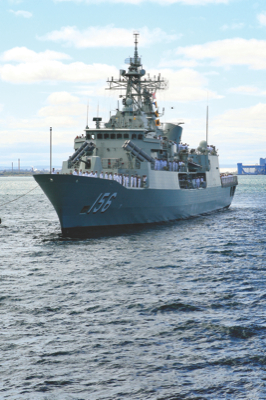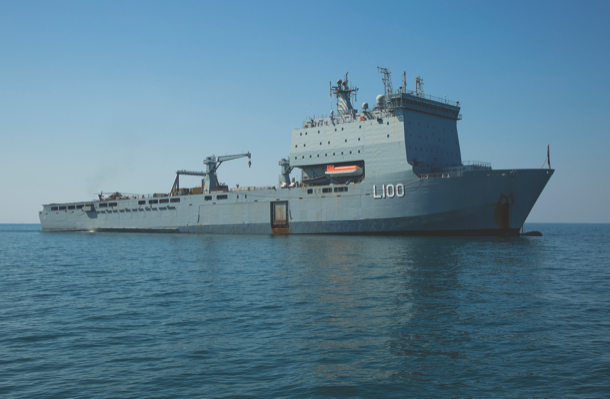At first glance, it might seem like the only thing these two efforts have in common is the UK accents of the management team. Both have their roots in the UK and have brought their expertise to the Australian market.
Naval Ship Management (Australia) Pty. Ltd. is a 50/50 Joint Venture between UGL and Babcock, established to execute the ANZAC Class Group Maintenance Contract (GMC Group 3). The Group Maintenance Contract between the Commonwealth of Australia and NSM was signed in May 2012 and was in full operation by October 2012.
The DMO at the time had articulated a clear desire to bring more certainty into the sustainment approach for the RAN’s surface fleet. This was the first time the batch approach was put in place. It was the chance to move from the previous short-term and unpredictable naval ship maintenance contracts to a new grouped asset (‘batched’), long-term, performance based contracting methodology for the repair and maintenance of the Navy’s major fleet units.
 HMAS Toowoomba approaches the pier at Fleet Base West after a six months on Operation Slipper. Credit: Defence
HMAS Toowoomba approaches the pier at Fleet Base West after a six months on Operation Slipper. Credit: Defence
“It’s a thin joint venture which means that employees from our parent companies are seconded in to the joint venture itself and then they provide the operations, management and deliver the maintenance itself,” Craig Lockhart, Babcock Australia’s CEO said to ADM. “This was a deliberate decision to keep overheads low for the customer. So the RAN and DMO get all the benefits of having the reach back to two large companies but only pay for the people on the ground.”
This approach sees about 60 people from the two companies functioning as NSM, with 80 per cent of the workforce based on the west coast in the Henderson/Rockingham area and the balance in Sydney on the east coast. This supports the home basing split of the fleet where five ships are based in the west and three in the east.
“We then have anywhere between 300-400 contractors in place depending on the tasking,” Alan Beacham, UGL’s executive general manager for rail, defence and international explained to ADM. Lockhart was proud to point out that almost 100 per cent of the demand from the
program is supplied by Australian companies. While each maintenance tasking is different, recent experience with HMAS Stuart is a good example of what NSM does for the ANZAC fleet. This was a difficult task for all involved as the ship had effectively been mothballed for anywhere between 18-24 months beforehand.
“There were about 400 individual taskings for that full cycle docking at the graving dock in Sydney for Stuart at the end of last year,” Beacham said. “These all come through AMPS, the asset management program system.”
NSM also works alongside BAE Systems in the west in regard to the ASMD ships for general maintenance tasks in regard to those hulls.
In comparison to the old arrangements where each maintenance task was bid for by a panel of providers, both Babcock and UGL are much happier with the batching framework that gives them much more certainty of schedule, scope and demand.
“The consistency of the group maintenance contract has given us the chance to work with AMPS (Asset Management Planning System), to update that system significantly and make sure the data is consistent,” Beacham said.
The performance based nature of the contract drives where and what NSM invest their time and effort. This has driven the development work on the customers' AMPS that will deliver a consistent approach to standards and what Lockhart calls ‘a single source of truth’ for maintenance efforts. This has allowed NSM, the systems program office and the RAN to see patterns in engineering and maintenance tasks that can be dealt with in advance. The building of the relationship between the players has had welcome benefits. Stuart was the first stern first docking into the floating dock and this allowed NSM and the SPO to come up with an innovative way of changing the shaft line and the propeller in and out. These tasks have taken up to 12 weeks previously but just three days were taken to approve the safety justification and a further week to execute.
“We’re not just providing maintenance bandaids to the program,” Lockhart said. “We’re on the front foot in every sense of the word now. As far as I’m concerned, a happy jetty is an empty jetty.”
HMAS Choules
At the other end of the spectrum in term of fleet size is HMAS Choules, a single vessel alone in her class for the RAN, now under a support contract with A&P Australia.

HMAS Choules. Credit: Defence
The UK based sister company of A&P Australia, A&P Group Limited (A&P), has been looking after Choules since she was RFA Largs Bay in the UK as part of a four ship strong fleet. The cluster framework in the UK (comparable to the group maintenance approach here in Australia) sees A&P taking care of the Royal Fleet Auxiliary’s (RFA) Bay class fleet in Falmouth, in the southwest of England. Since 2004 A&P, in conjunction with the RFA, undertook a pilot contract to establish the feasibility of ship repair contractors having a more active role in the maintenance of the RFA Flotilla.
This resulted in A&P being awarded a five-year rolling cluster support contract in 2008. They have since been awarded a second five-year contract that extends until 2018. Under the cluster support progam, A&P provides maintenance support to groups of UK MoD vessels which include RFA Argus and the RFA Bay Class vessels Mounts Bay, Cardigan Bay and Lyme Bay.
Earlier this year, A&P was awarded a multi-million pound UK MoD contract to complete the customisation, trials, testing and support of the Royal Fleet Auxiliary’s new fleet of four Military Afloat Reach and Sustainability (MARS) tankers.
These Tide-class tankers are currently under construction in South Korea with the first tanker, RFA Tidespring, due to arrive in the UK in December 2015. She will be followed by her three sister ships at six-monthly intervals.
A&P established a branch office in Australia when Largs Bay became HMAS Choules while the Australian company A&P Australia was established to support the long term aspirations of the Group with regard to both HMAS Choules and the region in general. The Australian presence of A&P Australia is modest, with around 30 people based in premises at Sydney’s Garden Island Defence Precinct. As you would expect, there are more than a few UK accents in the building but the local contingent is growing.
Up until the point where the longer term was signed this year, A&P had been supporting Choules on a series of rolling three-month contracts since Christmas 2011, roughly three and half years. While this was not ideal for either the RAN or A&P in terms of cost effectiveness and scheduling it meant that Choules was in the same hands that had been looking after her for many years.
When ADM visited the A&P Australia offices last month, the company was in the process of a leadership hand over between outgoing general manager Paul Blake and Scott Willey. Blake is headed back to the UK to be an Australian advocate in the head office with the longer-term support contract now in place. He leaves Choules in good hands as Willey lived and breathed Bay class sustainment for over six years in the UK before heading out to Australia.
While A&P initially used some support from Thales to get Choules up and running for the RAN, the company now relies on its own local supply chain. Thanks to their work in the commercial sector globally, they were able to bring a number of non-traditional Defence SMEs to work on Choules such as Hallidays and KHR. Both these companies, for example, have done the majority of their marine repair work with Sydney Ferries. This helped bring some commercial rigour and thinking to the process while establishing the Australian maintenance supply chain.
“The new in-service support contract is essentially a fixed price arrangement for the two year period,” Blake explained to ADM. “We were able to build on the work that we had done here to win that contract. A&P’s operations were predominantly a waterfront-based team here; engineers in the main. A&P Australia has now developed this into a much broader service offering of engineering and maintenance management, ILS, life cycle costing analysis and supply chain management combined with more robust reporting deliverables to meet the Commonwealth’s governance requirements.
“We’ve never had Choules come out of maintenance late and she had more materiel ready days than other RAN ship last year.”
In terms of what the $60.6 million two-year deal buys the Commonwealth is certainty.
“That $60.6 million buys the A&P team for all scheduled maintenance, supply chain management, life cycle costing and analysis, and all the integrated logistics support,” Blake explained to ADM.
A&P are able to invest in their local presence more, plan work with a more concrete schedule in mind and train up the next generation of Choules specialists. At the moment, the company are taking on about one new person a week to meet the contract requirements. The relationship between a small program office and a small commercial entity that has been in place under different guises for five years on a single ship had paid dividends for both parties. You know who you’re talking to if you pick up the phone with an issue, the decision loop is tight and flexibility is shown by both parties as needed.





